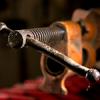I'm in the planning stages for a pair of stickley style end tables. I want legs that are about 2" square with the QS gain and rays on all 4 sides. I think Stickley did this by using a mitered lock joint leg with a hollow center. I'm not concerned with using his techniques for the sake of authenticity.
I'm thinking of laminating 4/4 stock and then using 1/8" to veneer the edges. The finished veneer would be between 1/16 and 3/32 and the tiny joint would be well hidden by a chamfer or roundover on the edges.
Has anyone tried this technique? If so, do you have any tips or tricks? Is there a better way to to get 4 QSO faces?
Thanks in advance.





 Reply With Quote
Reply With Quote



 I also added small bevels on the leg bottoms for the same reason.
I also added small bevels on the leg bottoms for the same reason.





